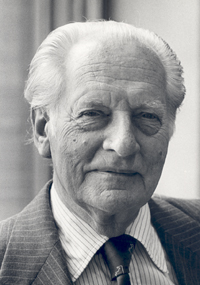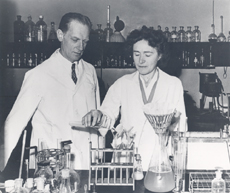Carl F. Cori (1896-1984)
Carl Ferdinand Cori was born in Prague in 1896 and spent his childhood in Trieste where his father was director of the Marine Biological Station. After graduating from the gymnasium in Trieste in 1914, Carl entered the German University of Prague to study medicine. His interest in science was not surprising – his great-grandfather was an anatomist, his maternal grandfather was a professor of theoretical physics, his uncle was a professor of chemistry, and his father was a leading zoologist and marine biologist.
At the university Carl Cori met Gerty Theresa Radnitz, a fellow medical student who shared his love of science and the outdoors. Cori’s training was interrupted by the First World War when he was drafted into the Austrian army and sent to serve as a lieutenant in the Sanitary Corps on the Italian front. Returning to the university in 1918, Cori resumed his studies. In 1920 both Carl Cori and Gerty Radnitz received their medical degrees. The couple married in August of that year in Vienna, where both had gone to complete postdoctoral work. The year 1920 also marked the publication of their first joint scientific paper, which was based on an immunological study of the complement of human serum. Their scientific collaboration would continue until Gerty Cori’s death in 1957.
Carl Cori spent a year at the University of Vienna and a year as assistant in pharmacology at the University of Graz. In 1922 he accepted a position as biochemist at the State Institute for the Study of Malignant Diseases (now Roswell Park Cancer Institute) in Buffalo, New York. Gerty Cori emigrated six months later, taking a position as an assistant pathologist at the Institute. Strong opposition at the Institute prevented Carl and Gerty Cori from working together at first. However, within a year or so they were allowed to resume their collaboration on carbohydrate metabolism.
In 1931 Cori was appointed professor and chairman of the Department of Pharmacology at the Washington University School of Medicine in St. Louis. (Gerty Cori was given a position as a research fellow at a token salary.) In 1942 he became professor of Biochemistry. In 1946 Carl Cori switched departments and became chair of the department of Biochemistry.
The Coris most notable contribution to science was their series of discoveries that elucidated the pathway of glycogen breakdown in animal cells and the enzymic basis of its regulation. Those discoveries formed a linear sequence that fell into four parts: the Cori Cycle – “cycle of carbohydrates” (1922-31); the Cori ester – glucose 1-phosphate (1931-37); phosphorylase and the cellular pathway of glycogenolysis (1937-44); and the regulation of phosphorylase (1945-52). In a biographical memoir published in 1986, Sir Philip Randle noted that Carl and Gerty Cori’s research “was characterized above all else by intellectual rigour applied with equal force to experimental methods and techniques (physiological and chemical); to a profound knowledge and critical appreciation of the literature; to a generally dispassionate, though sometimes defensive, analysis of discrepancies; to a high degree of replication especially in animal experiments; and to a meticulous attention to detail especially in formulating hypotheses.”
Carl and Gerty Cori received the Nobel Prize in physiology or medicine in 1947 “for their discovery of the catalytic conversion of glycogen.” They shared the Prize that year with Bernardo Houssay of Argentina. Carl Cori described his research collaboration with his wife in his speech at the Nobel Banquet in Stockholm in December 1947: “Our efforts have been largely complementary; and one without the other would not have gone so far as in combination.” The couple’s lasting legacy included the training of successive generations of scientists – no fewer than six other future Nobel Laureates worked with Carl and Gerty Cori at their laboratory at Washington University: Christian de Duve, Arthur Kornberg, Edwin G. Krebs, Luis F. Leloir, Severo Ochoa, and Earl W. Sutherland.
Carl Cori was a member of the American Society of Biological Chemists, the American Academy of Arts and Sciences, the National Academy of Sciences, the American Chemical Society, the American Philosophical Society, the Royal Society (London), the Royal Danish Academy of Sciences, and the American Association for the Advancement of Science. Carl and Gerty Cori were presented jointly with the Midwest Award (American Chemical Society) in 1946 and the Squibb Award in Endocrinology in 1947. Carl Cori also received the Lasker Award of the American Public Health Association (1946), the Willard Gibbs Medal (1948) and the Sugar Research Foundation Award (1947, 1950). Carl Cori received honorary Doctor of Science degrees from several universities, including Yale, Western Reserve, Boston, Cambridge (England), Brandeis, St. Louis, Monash (Austria), Granada (Spain), and Washington. The University of Trieste (Italy) awarded him an honorary M.D. degree. The American Chemical Society designated the research of Carl and Gerty Cori on the metabolism of carbohydrates at The Washington University School of Medicine a National Historic Chemical Landmark on September 21, 2004.
In 1960 Carl Cori married Anne Fitzgerald-Jones. The two shared many common interests, including archaeology, art, and literature. Cori retired from Washington University in 1966 and he and his wife moved to Boston. There Cori was appointed visiting professor of Biological Chemistry at Harvard Medical School and maintained a laboratory at Massachusetts General Hospital. In collaboration with noted geneticist Salomé Glüecksohn-Waelsch of the Albert Einstein College of Medicine, Cori began studying the regulation of enzyme synthesis at the level of gene expression. Their research continued until 1983 when he became too ill to continue. Carl Cori died in October 1984.

Related Resources:
- Carl F. Cori Bibliography
- Images of Carl F. Cori
- Carl F. Cori Oral History
- Gerty T. Cori Biography
- American Chemical Society Landmark Designation
Back to Biographies


